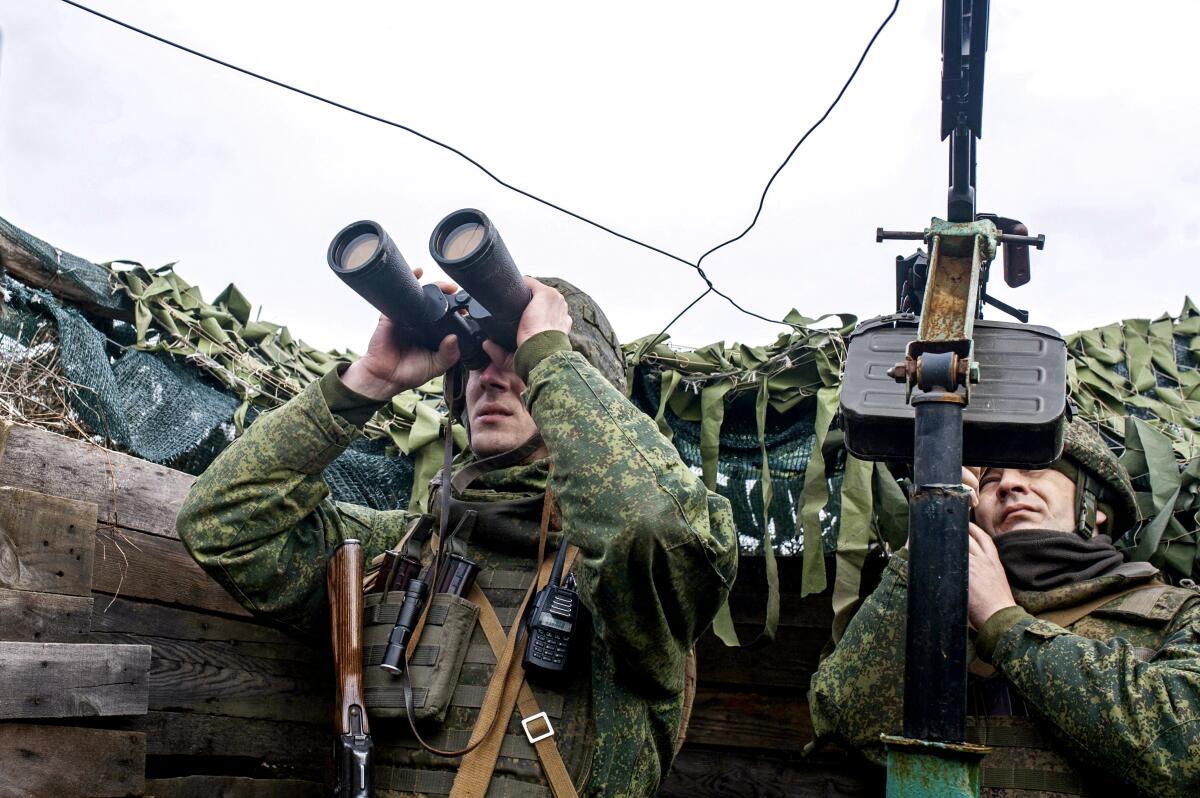Op-Ed: On display in Ukraine: the dangerous, futuristic world of virtual war

Imagine you’re a young Russian soldier in northern Ukraine — frightened, shivering in a tent, trying to stay warm in the middle of an icy, moonless night.
You surf the internet on a stolen cellphone, nervously scrolling through Ukrainian news feeds, TikTok videos and tweets about the stalled Russian military convoy to which you belong. You’re struggling to cut through the fog of war.
Off in the distance, you hear a buzzing noise, like a swarm of bees. It gets louder — then suddenly, intense flashes light up the tent. Blasts rip through the frigid air.
You look outside just in time to see three small spider-like “octocopter” drones, controlled by Ukrainian hobbyists lurking nearby, whiz away as acrid clouds of smoke billow from burning supply trucks.
Welcome to the world of virtual warfare.
Russia’s invasion of Ukraine illustrates just how fast the battlefield is changing. Today, war is increasingly fought from a distance — virtually — by remote control, automated systems, artificial intelligence and social media.
To get a sense of how quickly the change is happening, think about the last time a global superpower attempted to overthrow a sovereign government.
That was 2003, when our own country invaded Iraq.
Back then, even remote-controlled armed drones were a novelty — and robotic and autonomous weapons were science fiction, not science fact. Facebook’s News Feed didn’t exist. Neither did Twitter, WhatsApp or WeChat. Fast forward to 2022.
At first glance, the war in Ukraine doesn’t look much different than other armed conflicts. Russian forces use tanks, fighter planes, naval vessels, amphibious warships and attack helicopters, while Ukrainians fight back with antitank weapons, grenade launchers and antiaircraft missiles. This is what most of the war looks like on the ground.
But if we look deeper, Russia’s invasion of Ukraine gives a glimpse into the future of armed conflict.
Drones are the centerpiece of virtual wars.
Ukraine’s military is using dozens of Turkish-made remote-controlled drones armed with guided missiles to attack Russian forces. These drones look like small airplanes, and each one can cost more than a million dollars.
Although they are relatively slow, they’ve been surprisingly effective.
Reports have also emerged about a group of Ukrainian volunteers that has helped the military acquire small commercial cargo drones — the kind you can buy online for a few thousand dollars — to spy on Russian troops, and drop bombs and rocket-propelled grenades on them. For years, Russia has been developing autonomous drones, but so far, observers have seen few of them in Ukraine.
In the meantime, the Biden administration plans to send 100 “loitering missiles” — sometimes called suicide drones — to the Ukrainian military. These weapons are like cruise missiles, but they can wait passively in the sky near a particular area, only striking once their targets are located.
Another aspect of virtual war is the use of artificial intelligence, which has a staggering range of military applications. Think of it as war by algorithms.
Five years ago, with help from the tech industry, the U.S. military used AI to analyze millions of high-resolution photo images taken by surveillance drones in Iraq, Syria and Afghanistan to help hunt down its enemies. Russia and Ukraine may soon do the same.
AI can also be used to analyze open-source intelligence such as blog posts, TikTok videos or tweets that can reveal troop movements or attacks — or to anticipate troop movements by quickly scanning satellite imagery.
The first indications of the Russian invasion, for instance, appear to have come from Google Maps. The app showed unusually severe traffic jams at the Ukrainian border in late February, caused by Russian military convoys.
The third prong of the new virtual battlefield is the increasing reliance on high-tech, data-driven psychological operations. In theory it’s a lot like old-fashioned propaganda— but the fight is now being waged over the internet in a high-stakes battle for hearts and minds.
Social media platforms allow propagandists from all sides to disseminate messages and images, including deceptive and manipulated ones. A recent video that went viral, for example, portrayed what looked like a young Ukrainian girl confronting a Russia soldier. In fact, the video was made in the West Bank in 2012 — the girl was Palestinian, and was defiantly shouting at an Israeli soldier.
This is the new world we’re stumbling into. Virtual war means that Big Tech will increasingly join forces with Big Defense — and given the economic and military power of these industries, that should give us pause.
The prospect of virtual war was originally a seductive one. In its earliest iterations, it held out the hope that someday we might be able to conduct wars without soldiers, without physical battlegrounds and maybe even without death.
But data-driven warfare may turn out to be deadlier than anything in the past, especially with the advent of lethal autonomous weapon systems — what some call “killer robots” or “slaughterbots.” These technologies use algorithms to locate targets and to determine when and where to attack.
Autonomous weapon systems take human decision-makers out of the equation.
Last month, U.N. delegates in Geneva were working to create a treaty on lethal autonomous weapons — but formal agreements are still a distant dream, even as some experts warn of a global “AI arms race.”
Though such developments are ominous, there has also been some pushback. A broad coalition of nearly 200 nongovernmental organizations, known collectively as the Campaign to Stop Killer Robots, has taken a stand against these weapons, and within the tech industry, there’s a growing movement of workers fighting back against the militarization of Big Tech.
There’s still time to act — and we should.
Roberto J. González is chair of the anthropology department at San Jose State University. His latest book is “War Virtually: The Quest to Automate Conflict, Militarize Data, and Predict the Future.”
More to Read
A cure for the common opinion
Get thought-provoking perspectives with our weekly newsletter.
You may occasionally receive promotional content from the Los Angeles Times.






